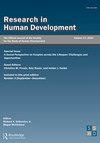FAMILY RELIGIOUSNESS, PEER RELIGIOUSNESS, AND RELIGIOUS COMMUNITY SUPPORTIVENESS AS DEVELOPMENTAL CONTEXTS OF ADOLESCENT AND YOUNG ADULT RELIGIOUS DEIDENTIFICATION
IF 1.4
4区 心理学
Q4 PSYCHOLOGY, DEVELOPMENTAL
引用次数: 4
Abstract
The purpose of the present study, grounded in relational developmental systems theory, was to use longitudinal data to examine the roles of individual, family, peer, and religious community predictors of religious deidentification in adolescence and young adulthood. The sample included 2,842 youth (ages 13–17) who identified with a religion at the baseline wave of the National Study of Youth and Religion (NSYR). First, Wave 1 individual (worship service attendance, youth group attendance, religious importance, prayer, and doubt), family (parent worship service attendance, parent religious importance, and family religious conversations), peer (number of religious friends, number of friends attending religious youth groups, and friend religious conversations), and religious community (engagement and dialogue) predictors were identified that significantly predicted deidentification by Waves 2 or 3. Second, when comparing Wave 1 individual, family, peer, and religious community scale scores as predictors of Wave 3 deidentification, only individual and family religiousness were significant. Third, we tested a mediation model whereby Wave 2 individual religiousness mediated relations between Wave 1 family, peer, and religious community scale scores and Wave 3 deidentification. All three indirect paths were significant, with the largest effect for family. Thus, individual, family, peer, and religious community factors all play a role in religious deidentification, but the family may be the most salient developmental context of religious development.家庭宗教信仰、同伴宗教信仰和宗教社区支持:青少年和青年宗教去认同的发展背景
本研究以关系发展系统理论为基础,目的是利用纵向数据来检验个人、家庭、同伴和宗教社区在青春期和青年期宗教去认同的预测因素的作用。样本包括2,842名青少年(13-17岁),他们在国家青年与宗教研究(NSYR)的基线波中确定了自己的宗教信仰。首先,波浪1个人(敬拜服务出席、青年团体出席、宗教重要性、祈祷和怀疑)、家庭(父母敬拜服务出席、父母宗教重要性和家庭宗教对话)、同伴(宗教朋友人数、参加宗教青年团体的朋友人数和朋友宗教对话)和宗教社区(参与和对话)预测因子被确定为波浪2或3显著预测去认同。第二,当比较第一波个人、家庭、同伴和宗教社区量表得分作为第三波去认同的预测因子时,只有个人和家庭的宗教信仰是显著的。第三,我们测试了一个中介模型,即第二波个人宗教信仰介导了第一波家庭、同伴和宗教社区量表得分与第三波去认同之间的关系。三种间接途径均显著,其中对家庭的影响最大。因此,个人、家庭、同伴和宗教社区因素都在宗教去认同中发挥作用,但家庭可能是宗教发展最显著的发展背景。
本文章由计算机程序翻译,如有差异,请以英文原文为准。
求助全文
约1分钟内获得全文
求助全文

 求助内容:
求助内容: 应助结果提醒方式:
应助结果提醒方式:


